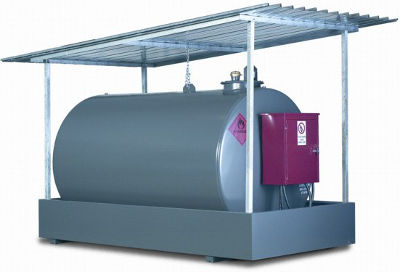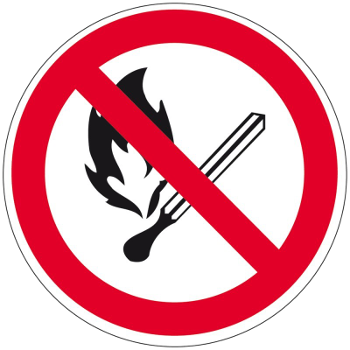In order to prevent accidental spills of dangerous products stored in cans, drums, cubitainers, etc. and to protect the environment and the people who handle them, the decree of 2 February 1998 “relating to the withdrawal and consumption of water as well as to emissions of any kind from installations classified for the protection of the environment and subject to authorisation”, requires the storage of hydrocarbons in a retention tank.

Fixed tanks
All steel or plastic tanks must be designed and manufactured for the storage of petroleum products. There must be no extraction point at the bottom of a container or tank. No pipework shall be connected to the bottom of a tank.
The tank shall be equipped with a gauging device to indicate the amount of liquid remaining in the tank. Glass or plastic level tubes are not permitted.
Any orifice allowing direct gauging shall be closed, outside the gauging operations, by a watertight shutter. The filling orifice must be closed, outside of supply operations, by a watertight stopper.
A plate indelibly indicating the name of the product stored and the total capacity of the tank(s) served shall be affixed near the filling opening.
Transportable containers
Closed transportable containers are drums or canisters with a capacity of not more than 200 litres. These receptacles must be designed and manufactured to contain and transport petroleum products. They shall comply with the requirements of the regulation on the transport of dangerous goods by road (see section on TRANSPORT).
 These receptacles, whatever their capacity, shall be fitted with devices enabling them to be handled. They must bear a sign indicating the type of fuel packed.
These receptacles, whatever their capacity, shall be fitted with devices enabling them to be handled. They must bear a sign indicating the type of fuel packed.
The storage area
It is forbidden to smoke in the fuel storage premises (hydrocarbons) and in the open air near the external tanks. This prohibition must be indicated by means of a statutory sign.
The storage areas must be equipped with appropriate extinguishing equipment and in sufficient quantity (contact organisations specialising in fire protection).
Additional rules apply depending on the storage location (outside, in a building or underground) and the overall storage capacity.
Unburied outdoor storage
 Tanks installed outdoors must be designed to store petroleum products outdoors. The opacity of the tank must be sufficient to prevent alteration of the characteristics of the petroleum product stored.
Tanks installed outdoors must be designed to store petroleum products outdoors. The opacity of the tank must be sufficient to prevent alteration of the characteristics of the petroleum product stored.
In order to reduce as much as possible the risks of the tank moving under the effect of wind, water or vibrations, it must be solidly fixed to a flat masonry floor.
All metal parts (tanks, pipes and other accessories) must be connected to earth by an equipotential bond.
Receptacles or tanks must be equipped with a second leakproof casing and be designed in such a way that it is possible to detect any loss of leakage from the inner casing.
If there is no second casing, they must be placed in a leakproof holding tank whose capacity must be at least equal to the greater of the following values
- 100% of the capacity of the largest tank
- 50% of the overall capacity of the tanks and containers
Depending on the overall capacity of the storage, a minimum distance must be maintained between the tank wall and the nearest building:
- less than 2,500 L: no distance is required
- between 2 501 and 6 000 L: 1 m
- between 6 001 and 10 000 L: 6 m
- between 10 001 and 50 000 L: 7 m
- more than 50,000 L: 10 m
When the storage exceeds 15,000 L in total capacity, the distance between two tanks is 0.2 x L (L: maximum width of the largest tank) with a minimum of 1.50 m..
Regardless of the storage capacity, it is forbidden to light fires or store combustible materials other than the petroleum products stored:
- in all cases, less than 1 m from the secondary tank enclosure or, failing that, from the retention tank;
- in the enclosure of a fenced storage facility.
When the storage exceeds 15,000 L, it must be surrounded by a fence at least 1.75 m high.
No water, waste water, gas or electricity pipes may be laid under transportable containers and tanks, or in the retention tanks. Only branches that are essential for lighting or for the operation of equipment necessary for the operation of the storage are permitted.
The storage of hydrocarbons on the ground floor or in the basement of a building
 Tanks should be placed on a level masonry floor. They shall be firmly fixed to the ground if they are installed in a flood-prone area.
Tanks should be placed on a level masonry floor. They shall be firmly fixed to the ground if they are installed in a flood-prone area.
Containers or tanks, including transportable ones, shall be equipped with a secondary watertight, fire-resistant casing and designed in such a way that any loss of watertightness of the inner casing can be ascertained.
If there is no secondary containment, they must be placed in a leakproof, non-combustible containment tank with a capacity at least equal to that of the storage. The retention tank must be maintained in a satisfactory condition so as to remain leakproof and retain its initial capacity (free of any object or liquid reducing its capacity).
All measures must be taken to ensure that inside the room where the storage is installed and which also serves as a garage, the tanks are protected against any possible impact. They must not obstruct passage. The room containing the storage shall be adequately ventilated.
Where pipes pass through the walls and floors of the storage room, there must be no gaps between the walls (walls and floors) and the pipes. The shut-off device must allow the pipes to expand freely.
The electrical installation of the room shall be carried out with standardised equipment which may be of the ordinary type. Removable electrical equipment may only be supplied from very low voltage safety installations.
The storage area must be protected from sources of ignition such as fireplaces, flames and equipment that can produce sparks externally.
The room where the storage is installed must be able to be closed by a door with a fire resistance rating of at least one quarter of an hour. The walls and the upper and lower floors of the room must have a fire resistance of at least half an hour. The doors of these rooms shall open to the outside.
Details on storage in transportable containers:
When hydrocarbons are stored in closed transportable containers, the capacity of each container is limited to 60 L.
However, when this storage is located on the ground floor, this capacity may be increased to 200 L. It is forbidden to deposit and leave petroleum products in staircases, passages and corridors, under staircases and near the exits of premises and buildings.
Precisions for storage of more than 2,500 L:
The storage must be installed in an exclusive room if its overall capacity exceeds 2,500 L.
The walls and the upper and lower floors of this room must have a fire resistance of two hours. The door of the room must have a fire resistance rating of one hour, have a threshold if the room itself serves as a holding tank, open towards the outside of the room and be fitted with an automatic closing system and a device enabling it to be opened from the inside in all cases. In a building used exclusively for storage, a high floor is not required.
It is forbidden to light fires in the premises or to store combustible materials other than petroleum products. Any open flame generator or appliance with unenclosed incandescent elements is prohibited.
Ventilation must be provided by one or more openings with a cross-section of at least 1 dm² allowing fresh air to enter. If this ventilation is provided by means of a duct, it must be non-combustible and of sufficient impact resistance.
- Les articles R. 4227-22 à 27 du Code du travail « Emploi et stockage de matières explosives et inflammables ».
- Les articles R 4227-28 à 33 du Code du travail « Moyens d’extinction ».
- L’arrêté du 01/07/2004 fixant les règles techniques et de sécurité applicables au stockage de produits pétroliers dans les lieux non visés par la législation des installations classées ni la réglementation des établissements recevant du public.
- Legifrance.com, 02/02/1998, Arrêté relatif aux prélèvements et à la consommation d’eau ainsi qu’aux émissions de toute nature des installations classées pour la protection de l’environnement soumises à autorisation.
Find out more about the regulations governing the transport of hydrocarbons on the road and the ADR regulations, as well as the driving licence and registration rules for trailers.









